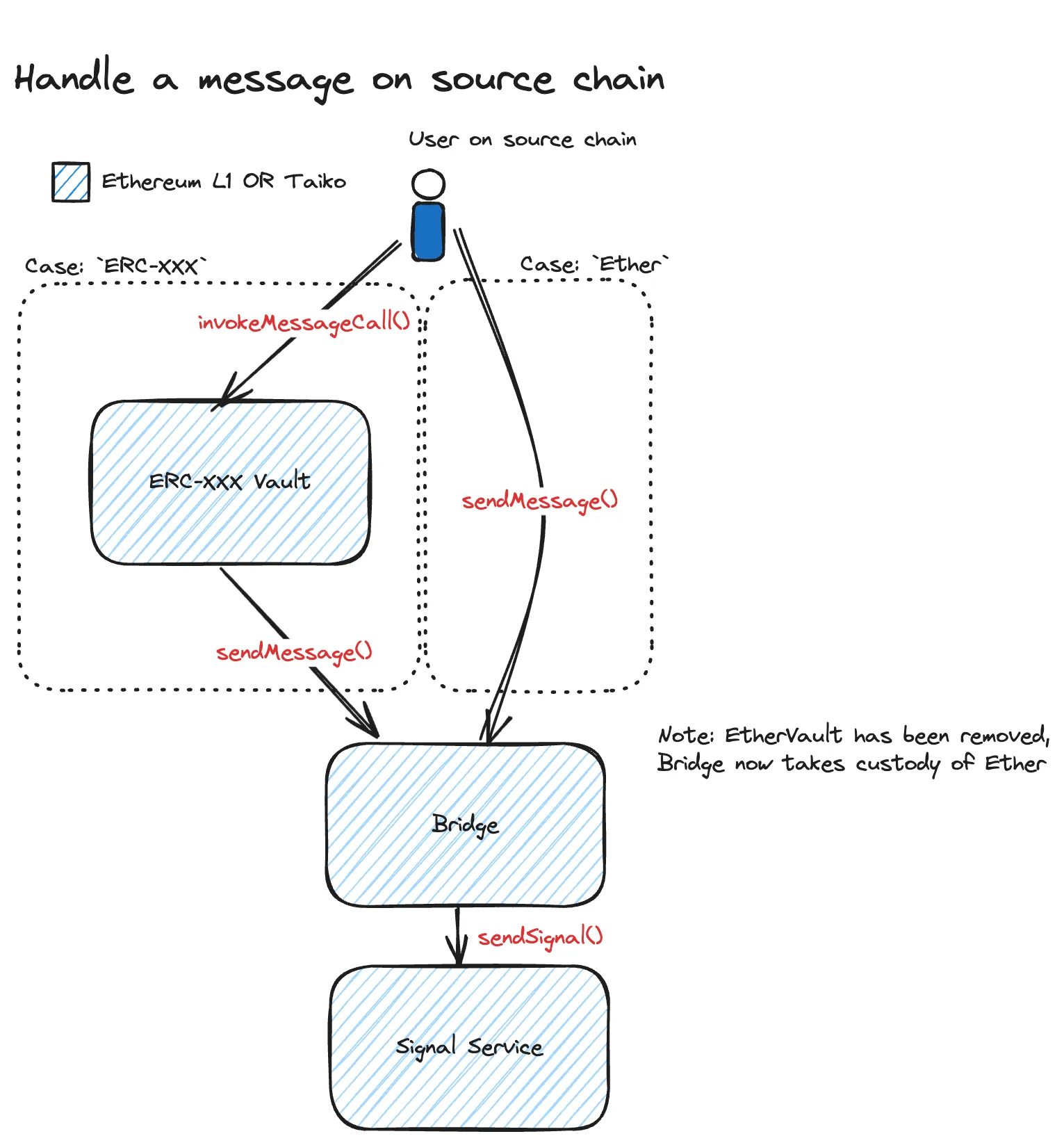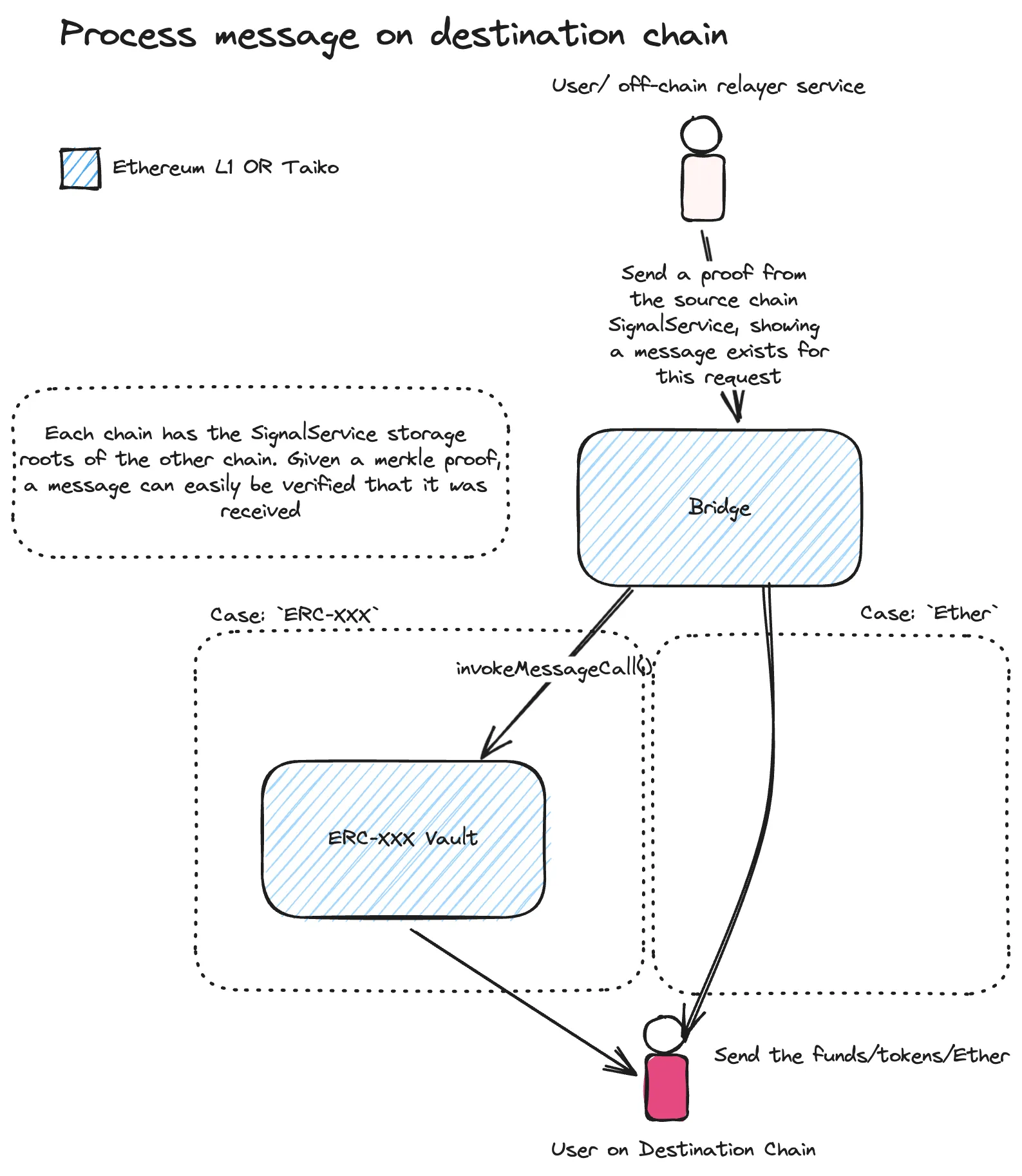Bridging
Bridges are foundational for cross-chain users and applications. Users might come to another chain, such as Taiko. To do this, they need to bridge over funds. Notoriously, bridging has been a dangerous operation. How do you make sure that this bridge is secure?
Let’s explain bridging on Taiko. We will answer the following questions:
- How does the Taiko protocol enable secure cross-chain messaging?
- What is the Taiko signal service?
- How does Taiko’s bridge implementation work?
Cross-chain messaging
The Taiko protocol’s design, specifically its Ethereum-equivalence enables secure cross-chain messaging. Let’s see how it works by simply using merkle proofs.
Taiko stores block hashes of each chain
Taiko deploys two smart contracts which store the hashes of the other chain:
- TaikoL1 stores the L2 world state root on L1 (deployed on Ethereum)
- TaikoL2 stores the L1 world state root on L2 (deployed on Taiko)
Every time an L2 block is created on Taiko, the world state root of the enclosing block on L1 is stored in the TaikoL2 contract using the anchor transaction. To ensure validity, it is part of the (previously the zk circuits, now SGX and ZK) proof data submitted with each block, so no fake L1 world state root can be synchronized to L2.”
The L2 world state root is stored in the TaikoL1 contract using the syncChainData function call in
LibVerifying.
Taiko by default synchronizes the world state roots cross-chain with the above mechanism.
Merkle trees enable verifying values exist on the other chain
Merkle trees are a data storage structure that allows a lot of data to be fingerprinted with a single hash, called the merkle root. The way that they are structured enables one to verify that some value exists within this large data structure, without actually needing to have access to the entire merkle tree. To do this, the verifier would need:
- The merkle root, this is the single “fingerprint” hash of the merkle tree
- The value, this is the value we are checking is inside the merkle root
- A list of intermediate sibling hashes (sometimes called paths or proofs), these are the hashes that enable the verifier to re-calculate the merkle root
The signalForChainData function is used to store and retrieve chain data in the SignalService contract. This is a multi-purpose storage function, we can sync the state root or signal service storage roots as needed for each chain respectively.
A verifier will take the value (a leaf in the merkle tree) and the sibling hashes to re-calculate the merkle root. If the calculated merkle root matches the one that is stored in the destination chain’s list of block hashes (the block hashes of the source chain), then we have proved that the message was sent on the source chain, assuming the source chain block hashes stored on the destination chain were correct.
The signal service
Taiko’s signal service is a smart contract available on both L1 and L2, for any dapp developer to use. It uses the previously mentioned merkle proofs to provide a service for secure cross-chain messaging.
You can store signals and check if a signal was sent from an address. It also exposes an important function: verifySignalReceived.
What does this function do? The first thing to understand is that the Taiko protocol maintains two important contracts:
TaikoL1TaikoL2
These contracts both keep track of the world state roots on the other chain. So TaikoL1, which is deployed on Ethereum, has access to the latest world state roots on Taiko. And TaikoL2, which is deployed on Taiko, has access to the latest world state roots on Ethereum.
So, verifySignalReceived can prove on either chain that you sent a signal to the Signal Service on the other chain. A user or dapp can call eth_getProof which generates a merkle proof.
You need to provide eth_getProof with:
- The signal (the data you want to prove exists within the storage root of some block on the chain)
- The address of the signal service (the contract address which stores the provided signal)
- The block number you are asserting the signal was sent on (optional—if you don’t provide this, it will default to the latest block number)
And, eth_getProof will generate a merkle proof (it will give the necessary sibling hashes and the height of the block, that along with the signal, can rebuild the merkle storage root of the block you are asserting the signal exists in).
This means, assuming that the hashes which TaikoL1 and TaikoL2 maintain are correct, we can reliably send cross-chain messages.
Let’s walk through an example:
- First, we can send a message on some source chain, and store it on the signal service.
- Next, we call
eth_getProof, which will give us a proof that we did indeed send a message on the source chain. - Finally, we call
verifySignalReceivedon the destination chain’s SignalService which essentially just verifies the merkle proof.verifySignalReceivedwill look up the block hash you are asserting you had stored a message on the source chain (where you originally sent the message), and with the sibling hashes inside the merkle proof it will rebuild the merkle root, which verifies the signal was included in that merkle root—meaning it was sent.
And boom! We have sent a cross-chain message. If this is confusing, you can also find a simple dApp that was built during one of our workshops to demonstrate the fundamentals. You can find it here.
How the bridge works
The bridge is a set of smart contracts and a frontend web app that allow you to send testnet ETH and ERC-20, ERC-1155 and ERC-721 tokens between Ethereum and Taiko. This bridge is just one possible implementation built on top of Taiko’s core protocol, specifically the signal service which anybody can use to build bridges.
First, here is a flowchart of how our bridge dapp implementation works, which uses the signal service:


How does Ether bridging work?
Taiko’s bridge utilizes the Signal Service we described. Here is the general user flow for Taiko’s bridge:
- The user sends their funds to the Bridge contract
- The Bridge locks the Ether, and stores a message by calling
sendSignal(message)on the SignalService contract - The user receives Ether on the destination chain, if they (or another) provide a valid merkle proof that the message was received on the source chain
With the current design there are 2 ways to bridge Ether:
Etheronly case: The user interacts directly with the Bridge contract by callingsendMessageERC-XXX+Ethercase: The user interacts with theERCXXXVault(ERC20, ERC721, ERC1155) because they want to bridge over some tokens, but if they fill themessage.valuefield,Etherwill also be bridged
How does ERC-20 (or ERC-721, ERC-1155) bridging work?
ERC-20 tokens originate from a canonical chain. To send a token and bridge it to the other chain, a new BridgedERC20 contract needs to be deployed on the destination chain.
Bridge from canonical chain to destination chain
Here are the overall steps for transferring canonical ERC-20 (the overall process is identical for ERC-721, and ERC-1155 token types as well!) from a source chain to the destination chain:
- A contract for the ERC-20 (or ERC-721, ERC-1155) must first be deployed on the destination chain (will be done automatically by the ERC20Vault if not already deployed)
- Call
sendTokenon the source chain ERC20Vault, this will transfer the amount by using thesafeTransferFromfunction on the canonical ERC-20 contract, on the source chain, to the ERC20Vault. - The vault contract (via the Bridge) sends a message to the Signal Service (on the source chain), this message will contain some metadata related to the bridge request, but most importantly it includes the calldata for the
onMessageInvocation()method. - Process the message on the destination chain by submitting a merkle proof (generated from the source chain), proving that a message is included in the state of the source chain Signal Service. After verifying this occurred and doing some checks, it will attempt to invoke the
onMessageInvocation()method encoded in the message. This will mint ERC-20 (or ERC-721, ERC-1155) on the BridgedERC20 contract to thetoaddress on the destination chain!
Bridge from destination chain back to the canonical chain
Okay now let’s do the reverse, how do we transfer a bridged token from a source chain to the destination chain? (Destination chain in this case is the canonical chain, where the original token lives.)
- A contract for the ERC-20 (or ERC-721, ERC-1155) already exists on the canonical chain, so no need to deploy a new one.
- Call
sendTokenon the source chain token vault contract, this will burn the ERC-20 on the BridgedERC20 contract. - The vault contract (via the Bridge) sends a message to the Signal Service (on the source chain), this message will contain some metadata related to the bridge request, but most importantly it includes the calldata for the
onMessageInvocation()method. - Process the message on the destination chain by submitting a merkle proof (generated from the source chain), proving that a message is included in the state of the source chain SignalService. After verifying this occurred and doing some checks, it will attempt to invoke the
onMessageInvocation()method encoded in this message. This will transfer the amount from the destination chain TokenVault to thetoaddress on the destination chain.